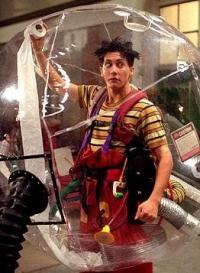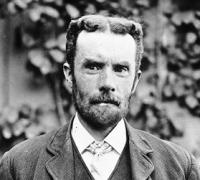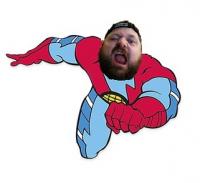
Optimimum length for a counter flow chiller?
#1

Posted 04 July 2012 - 11:06 AM
#2

Posted 04 July 2012 - 11:21 AM
#3

Posted 04 July 2012 - 11:22 AM
#4

Posted 04 July 2012 - 11:25 AM
#5

Posted 04 July 2012 - 11:48 AM
#6

Posted 04 July 2012 - 12:32 PM
None to very little.The greatest exchange of heat takes place at one end of the CFC. At the other end, there is very little heat exchange. Extending the CFC only extends section of little heat transfer.If you want to increase efficiency, look into methods to add turbulence to the cooling water and/or the wort. The easiest way is to wrap the outside of the copper tube with copper wire. You can tack solder the wire to the tubing at some intervals. Any thing that will break up the water and keep it from making a skin of water against the tubing is helpful.I have seen people modify the inside the copper tube to had turbulence to the wort. Those solutions have the potential problem adding material inside the tube, giving solid material a place to get stuck on.would there be any real advantage to longer than 20
#7

Posted 04 July 2012 - 05:14 PM
#8

Posted 04 July 2012 - 06:07 PM
#9

Posted 04 July 2012 - 06:52 PM
#10

Posted 04 July 2012 - 08:05 PM
I offered the external copper wire only as a "if you want to maximize" solution. Without a doubt, it will not hurt anything by doing it. The biggest consequence would be it could make assembly more difficult. There is some skin affect or the part of the water that is close to the tubing will tend to stay close to the tubing.The reality is you are putting one springy coil inside another springy coil, the sides of each tube bump into each other at random intervals, so I can concede there will not be "alot" of skin affect. Also explains why when I built my CFC, I did not do the wire around the outside tube trick.3/8" tubing seems to be the sweet spot for diameter. Oddly, I tend to think that if you went with 1/2'', you would actually require a greater length due to the difference in surface area to volume. Anything smaller than 3/8'', and I think you would have issues with pressure and having a good enough flow rate.I agree on not having anything on the inside of the tubing that contacts the wort. The main advantage of this over a plate chiller, in my mind, is that you have smooth copper for the wort where particles won't get stuck. I don't know if I am sold on the idea of tacking the copper wire to the outside. I've seen those plans, and honestly, I would rather have a slightly longer counterflow than try to modify the copper like that for a build.I am also thinking about a new chilling setup, and have been considering a counterflow chiller, maybe even two for a second stage.
I remember seeing an evaluation of a CFC chiller by a thermodynamic engineer. (sorry, I do not have link or reference) The conclusion was 15 feet was about all you "need", 20 feet was OK and there was not anything to gain going beyond 20 feet.The reason was, maximum heat transfer happens when the difference of the temps is the greatest. You put hot wort in one end, cool water in the other end. You run them in opposite directions.Let's say instead of a coil, we have two concentric tubes in a straight line. The cool water goes in on the left end and runs to the right and goes out the right end. Hot wort goes into right end runs to the left and goes out the right end.Cool Wort |< - - < - - < - - - < - - < - -| Hot WortCool Water |- - > - - > - - > - - > - - ->| Hot WaterOn the right end is when the wort is it's at it hottest AND the cooling water is at it hottest. This is where the minimum heat transfer happens. As the wort travels left, it heats up the cooling water. As the wort's temp is lowered it comes in contact with water the is getting colder, lowering the wort's temp more. The bulk of the cooling happens somewhere around the left half of the tube. Extending the tube extends the right end where there is little heat transfer and does not get you anything.There are a lot of factors that play into "ideal". There is average cooling water temperature. Cooling water flow rate, wort flow rate, how turbulent each is, and the dimension of the hoses to name a few. Really I think we would need to talk about the rest of your setup and the goals before getting to the best design.
I used to drop my IM in the wort and run water through it. Then I read about how the wort nearest the coils gets chilled and creates a "boundary." The wort beyond the boundary is "insulated" from the coils does not get chilled.This affect was proven to me when I put my hand on the part of the coil that the cooling water exits. I could put my had that part and it was not very warm. If I picked up the coil an inch or two, I could feel the part of the coil I was holding onto heat up very quickly.Some gentle agitation or movement is important with an IM.I am curious why you think your IC is no longer that good. Have you added stirring or similar to the cooling process? If not, that can be a huge improvement with the IC.
#11

Posted 04 July 2012 - 09:04 PM
#12

Posted 04 July 2012 - 09:05 PM
#13

Posted 05 July 2012 - 08:09 AM
Primarily my water is very very warm year round. I do the tap then ice thing but it is a lot of futzing around. This translates to me as another opportunity for something to splash / fall in etc..I want to be able drain straight from the kettle through the chiller in to the fermenter, add oxygen, yeast, close it up and wait.I have been running my pump recirculating around the Immersion chiller.There are a lot of factors that play into "ideal". There is average cooling water temperature. Cooling water flow rate, wort flow rate, how turbulent each is, and the dimension of the hoses to name a few. Really I think we would need to talk about the rest of your setup and the goals before getting to the best design.I am curious why you think your IC is no longer that good. Have you added stirring or similar to the cooling process? If not, that can be a huge improvement with the IC.
#14

Posted 05 July 2012 - 08:55 AM
recirculate ice water through the CFC as part of the chilling cycle. Basically, recirc the wort through the CFC while chilling with the IM. the cold wort coming into the kettle will help chill the batch faster.Primarily my water is very very warm year round. I do the tap then ice thing but it is a lot of futzing around. This translates to me as another opportunity for something to splash / fall in etc..I want to be able drain straight from the kettle through the chiller in to the fermenter, add oxygen, yeast, close it up and wait.I have been running my pump recirculating around the Immersion chiller.
#15

Posted 05 July 2012 - 10:02 AM
2 user(s) are reading this topic
0 members, 2 guests, 0 anonymous users












